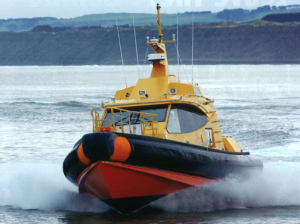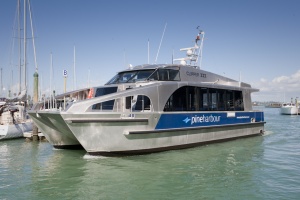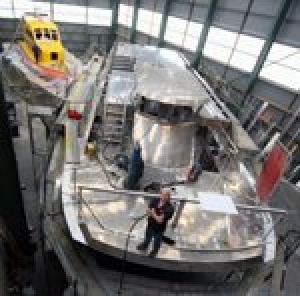
by admin | Apr 30, 2019 | Uncategorized
Wanganui Chronicle: 01.11.2008 by John Maslin
Multi-million-dollar contracts in New Zealand and the US have seen a Wanganui industry boom over the past few months, even as the national business outlook has worsened.
Q-West Boat Builders is now building vessels for Whalewatch Kaikoura and the Lake Manapouri power station plus private boats for the American market, requiring a large number of staff, including 20 boatbuilders.
Colin Mitchell, the company’s general manager, told the Chronicle yesterday that contracts already locked in place had secured a “huge amount” of work for the Castlecliff shipyard.
Work is already well advanced on a 19.5-metre vessel for Meridian Energy that will be used to transfer crew to and from the power station on Lake Manapouri. The aluminium vessel is due for launch in April.
Mr Mitchell said the company had been awarded a contract for Whalewatch Kaikoura to build five passenger vessels, each worth nearly $3 million.
“These are all significant contracts in dollar terms, and it represents a huge amount of work for us.”
Mr Mitchell said Q-West had recently taken on extra staff and now employed 26 full-time workers, with 20 of those in the workshop.
“There are other opportunities for us too and we’re chasing those as well.”
He said the Meridian vessel was designed in Australia and was the first time his company had built for that design firm. He was hopeful that would bring more work to Q-West as a result.
The company had just finished a boat for a buyer in the United States and that had gone to Nelson to be fitted out.
“The dollar dropping the way it is makes New Zealand an attractive place to build a boat for overseas buyers,” Mr Mitchell said.
“Normally, it would make it especially attractive for the US market, but the way the financial markets have gone there in recent months we haven’t been getting too many inquiries from that part of the world.”
But despite that blip the company was fortunate because their contracts ran for considerable periods.
“Generally building a boat covers a 12 to 18 month period,” he said.
“We’ve got the Meridian crew vessel due for delivery in April next year and we start building the first of the whale watch boats next week.”
The whale watch boat is a 12-month project and the four other 17.8m boats will follow progressively over the next seven years.
“We’ve also got a 15m hydrographic research vessel for Niwa (National Institute of Water and Atmospheric Research NZ)� Mr Mitchell said.
“We built the first Whalewatch boat about 10 years ago and over the years we built another four boats for them.
“They had to decide whether they wanted to replace the fleet or refit the existing boats, and they decided on replacements.”
Q-West had delivered a service vessel to Port Taranaki a few months ago, and has the port company’s pilot boat here for a refit.
PICTURED: Riding a wave … Colin Mitchell, general manager of Q-West Boat Builders, on the bow of the crew transfer vessel his company is building for Meridian Energy. The 19.5-metre long aluminium boat will take workers to and from the power station at Lake Manapouri.
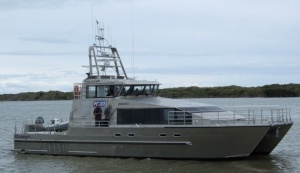
by admin | Apr 30, 2019 | Uncategorized
By Lindsay Wright and Keith Ingram
One of the most thoughtful and exhaustive boat searches ever conducted in New Zealand came to fruition towards the end of last year when Q-West in Wanganui launched Deodar III Auckland’s latest police boat. The officer in charge of the Auckland Police Maritime Unit, Senior Sergeant Martin Paget, began looking for a new boat to replace the unit’s ageing Deodar II about two years ago. “The Deodar II is 15 years old, and there have been significant advances in hull design and construction materials since we bought her. We didn’t just want to replace what we had with a new version of the same thing,” Martin said. And to ensure this did not happen the Police team who drew up the specifications or wish list, specified outcome results and left it to the designers to come up with the answers.
Auckland’s Hauraki Gulf and coastline is a big beat to cover, and a police boat must fulfil roles as a search and rescue platform, fire engine, prison van, police car, ambulance, command and communications centre and bus for personnel transfers or to assist as a customs or fisheries patrol vessel. The police boat has to be able to do all that, and be routinely manned by a crew of two,” he said.
Selecting a new police vessel would normally fall to a panel of the people who have to use her and this held true for the new Deodar III. “But that’s very subjective. Every skipper has his likes and dislikes, so we looked around for a way to gather hard data about boat performance.”
“We tested boats from all over New Zealand and Australia and then ran the results past our panel of expert boat operators from Police, Customs and other specialists before opting for a designer/builder combination to supply the Deodar III. The tender process resulted with the Teknicraft Design/Q-West Boat builder’s combination coming up trumps for its ability to meet our needs and cost effectiveness.”
Teknicraft, an Auckland design office founded by an expatriate South African, Nic de Waal, has specialised in power catamarans for over 20 years, and their boats are operating successfully in diverse roles all over the world.
Q-West is a Wanganui aluminium boatbuilding company with a reputation for quality construction and finish, whose boats are also in service all over the world, including the ferry Pine Harbour and the Kaikoura Whale Watch vessels Te Ao Marama and Wheketere.
Deodar III’s two hulls are plated with 6mm Sealium marine alloy, a lightweight plating designed for high-speed ferries, which is said to have about 15 percent more welded strength than conventional 5083 marine alloy plating. Her topsides and deck are built of 4mm Sealium plate.
She has non-skid coating on the decks, but the rest of the boat will be left unpainted. “No paint saves hugely on maintenance and weight, which in turn, converts to less fuel consumption,” says Martin. Her Intersleek fluoropolymer antifouling will also save fuel. The super-slippery coating prevents marine growth from taking hold without using biocides.
Among the Maritime Police Unit criteria for its new vessel was that she be able to maintain a service speed of 25 knots using a maximum 70 percent of available engine power, achieve her service speed in seas of up to 1.5m, and remain operationally effective in seas up to 4m high. The end result has been a service speed of 30 knots at 62% power and a top speed that will nail most boy racers afloat.
Teknicraft came up with an 18.5m catamaran with variable lift hydrofoil between the hulls, which fitted the tender conditions perfectly. Powered by two 8V2000 MTU diesels producing 808kW each at 2100rpm drive Hamilton 403 jet units using Blue Arrow electronic controls to take the long arm of the law out to where it’s needed in a hurry. MTU’s were chosen for their fuel efficiency and compliance with emissions standards for at least the near-future.
The intercooled V8 MTU’s drain their fuel from 4700 litre underfloor tankage forward of the engine rooms, and two 18.5kW Lombardini generators supply 230 volts for household and onboard appliances. The design brief was that the Deodar III, and ultimately her sister ships carry enough fuel for 400 miles at 25 knots, with some in reserve.
North Star computerised monitors will keep an eye on engine fluid levels and operating temperatures and all readouts will be instantly available on a monitor in the wheelhouse. Bilge water levels and pumping frequencies and times will also be electronically logged.
“One of the neat things about the boat is that just about all her systems use Kiwi-made,” says Martin. “And we didn’t go for them just because they were locally made. We chose Kiwi technology because it was the best available for our application.”
The Deodar III’s 6.9m beam provides her with a huge saloon area, which is fitted with tracks so that ferry-style seating for up to 30 passengers can be fitted. A multi purpose cabin on the port side accessed from both the aft deck and main cabin doubles as a hospital bay and will take a standard St Johns stretcher, or extra accommodation, or as a small “brig” to be used to restrain cuffed prisoners. Yes they do cuff prisoners to hold fast points between their legs at sea both for the prisoner’s safety and the crew of the vessels. One can imagine the damage a run-amuck prisoner could do in a short time not forgetting beating up on other prisoners if allowed his freedom. There is a full galley forward to supply sustenance during duty days or extended operations. This includes a 4 burner stove and oven, a large microwave and large onboard refrigerators and freezer. Cabins on board provide bunks for up to nine personnel.
The interior incorporates Ayres composite panels that use an aluminium honeycomb core with a paint finish bonded to the outside. “Its ultra light, strong, easy to maintain and can be bent to take a nice radius,” Colin says. The interior design colour layout was done by Parkhurst Design.
An onboard water-maker will produce about 57 litres of potable water an hour to supplement the 600 litre onboard tankage. This is to ensure that the vessel has water capability for extended deployments while not carrying a whole lot of extra weight around.
The Deodar III is intended to be the first of a series of coastal patrol class vessels to be built for multi agency utilisation which includes Customs, Fisheries and other marine police units. The intention is that when New Zealand Customs and Police eventually replace their other craft, the new vessels will be identical. “This will enable crews to mix and match from boat to boat, and role to role, without reorientation or training,” says Martin.
Among the systems they will be using is an Ocean lift crane personnel recovery system. A fold-down platform on the Deodar III’s hull will enable survivors (or bodies) to be recovered from the sea, and an electric davit, operated from an outside steering station, will lift them safely aboard. “It’ll enable a two-person crew to rescue several people at one time,” he said.
A hydraulically operated cradle between the two hulls at the stern will also enable fast and safe shorthanded launching and retrieval of the Deodar III’s Aquapro RIB rescue boat. The 4.5m RIB has Hypalon flotation chambers and is powered by a 60hp, four-stroke Yamaha outboard. This unique design will enable the launching and recovery of the tender with up to 6 persons onboard in reasonable seas and speeds of up to 15 knots
Up forward, the two hulls have huge stowage space for deck equipment. Gas bottles are kept in a ventilated locker to starboard, and a hydraulic reel capstan holds 50m of chain and 100m of warp for the 60kg Manson anchor.
The Hamilton jets have a water outlet to provide high-pressure jets for the fire fighting outlets, and a hydraulic reel winch situated on the after deck has 150m of 20mm towing warp stowed on it ready for use. “It’s generally safer to rescue a boat and her occupants than it is to take them off,” Martin said drily.
The wheelhouse has a range of North Star and Navman gear, all supplied by Crystal Electronics, at the three command stations. There’s a wheel position for the skipper, a navigation position and a tactical position. Each station has a screen that can access GPS, radar, radio, sonar and engine performance data. The communications system can monitor eight different frequencies at one time, including satellite and cellphone transmissions and all marine radio frequencies. Once the decision was made to stay with New Zealand design and build this philosopy extended to the electronics package or more importantly the intergration of all the systems said Martin. To this end we liked what we saw with Crystal Electronics. Not only did they listen and ask questions they came up with suggestions that would give us a system that far exceeded our expectations. They brought together a wide range of monitoring systems and electronic aids and pulled them together in a robust system that we are very pleased with he said.
A WASSP multi-beam sonar and bottom profiler by Electronic Navigation will enable the crew to check the seafloor for obstructions, sunken craft or drowned victims.
“But the most important component is the nut holding the wheel,” says Martin. All Police Marine Unit skippers are sworn police officers, and are qualified to Maritime New Zealand Offshore Watch keeper standard with command endorsement. They also undertake intensive and ongoing training.
“We’ve expanded the unit to handle our enhanced capability as our workload has increased exponentially over the last 10 years or so,” he says.
Access to the engine rooms is via internal watertight doors or by opening the large deck soft tops. Inside everything is well laid out with plenty of room to do onboard at sea checks and maintenance. The strong towing post is positioned just forward of the RHIB cradle with a towing warp locker and Maxwell capstan to aid recovery of the tow line.
The anchoring system is concealed and easy to use with both chain and wharp on a drum.
Deodar still has an external flybridge which while a secondary conning position is still suitable for when operating in public events or when doing searches for lost sailers and one needs to keep an ear out for the all important plaintive cry. But once in the confines of the main wheel house the command centre comes into its own with excellent all-round vision and the return to reverse sheer windscreen and eyebrow has eliminated most of the glare problems, improved vision and provide more space in the wheel house. There is the main coning position to starboard, a nav station to port and more central and a separate communications and command position slightly behind and to port. The master still retains the use of a large side window for when coming alongside or wishing to communicate with other persons or vessels alongside.
We asked the question why no paint or is the alloy treated Martin replied no nothing. Deodar II had no coating on the alloy and it took on a darkinsh grey patina which aided in concealing the vessel when on covert operations to no detriment to the alloy itself. By keeping the natural look gave the added cost savings as well which meant this money could be spent else where said Martin
Once commissioned in Auckland it was not long before Deodar III was into full work mode and during our visit the vessel had a crew of 3, two police and one customs as part of joint agency training.
To say we were impressed with the new craft would be an understatement. Every conceivable thought, consideration and implimentation has gone into the vessel to the stage where we believe this new generation patrol craft will be the fore runner of many more to come.
Specifications
Construction Sealium alloy
Length overall 18.5m
Beam 6.9m
Draught 750mm
Engines 2 x 8V2000 MTU diesels
Power 2 x 808kW
Drive 2 x Hamilton Jet 403 units
Service speed 25 knots
Fuel 4700 litres
Water 600 litres
Designer Teknicraft Design
Builder Q-West Boat builders Ltd
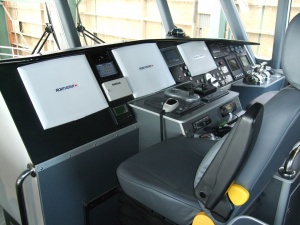
by admin | Apr 30, 2019 | Uncategorized
Complex electronics are carefully matched
The backbone of the Deodar III’s electronic systems is the Northstar 8000i network, which displays a multitude of different functions onto the four main 12in and 15in bridge screens and a single 12in screen on the flybridge.
The system was conceived, designed and manufactured in New Zealand. It employs innovative technology not seen previously in touch screen control, digital radar processing, professional series C-Map charting and specialist software that allowed the Police and Customs to specify control and display functions they could not have achieved elsewhere, says Bettina Latham of Crystal Electronics.
The autopilot is a new Northstar model that Hamilton Jet helped fully interface with the Blue Arrow steering package. New marine computers undertake specialist computing tasks.
GPS and heading information is provided by a Northstar master GPS and satellite compass that provides integrated navigation signals to the radar C-Map Max Pro charting system and autopilot. Two radars, a 4kw and a 10kw with new digital technology, and a standard 50/200KHz digital sounder complete the navigation package.
Sixteen antennae link the vessel’s Icom radios with marine shore-based stations and control centres for Police and Customs. “To ensure each radio channel operates to its designated specifications, we had special marine antennas manufactured, and created an antenna layout that minimises interference between radio services,” says Bettina.
In another innovation, all the radios are controlled via a network system that allows any operator to select any radio and monitor receiver traffic, transmit and select headphone operation if required. The New Zealand Police communications section undertook the final design and manufacture of these systems in New Zealand.
Night vision is enhanced with the latest combo Nightfinder from Carlisle & Finch, giving a fully controlled, high-power spotlight and built-in thermal imaging cameras with night and day ability. Images from the Deodar’s closed-circuit television cameras are all available on the Northstar network for viewing on the display screens.
Provision has been made for the new generation of satellite communications scheduled for our part of the world in early 2009, and the New Zealand designed and built WAAS sonar system from ENL Ltd is to be fitted later. An AIS class B transponder, a new Simrad unit with a built-in vessel display and integration to the 8000i network, is to come. Integration also allows for the future display of navigation and charting to the saloon television screens.
Engine and vessel monitoring with displays on the bridge screens was paramount. Tank levels, bilge pumps, DC and AC power systems, navigation lights and a full interface to the MTU engines, generators, watermaker and on-board pumps are all integrated into a standard mini-monitoring system from Yachtica. The system also incorporates a complete alarm log of all monitored functions so the crew can plan preventative maintenance of the engines and other systems.


